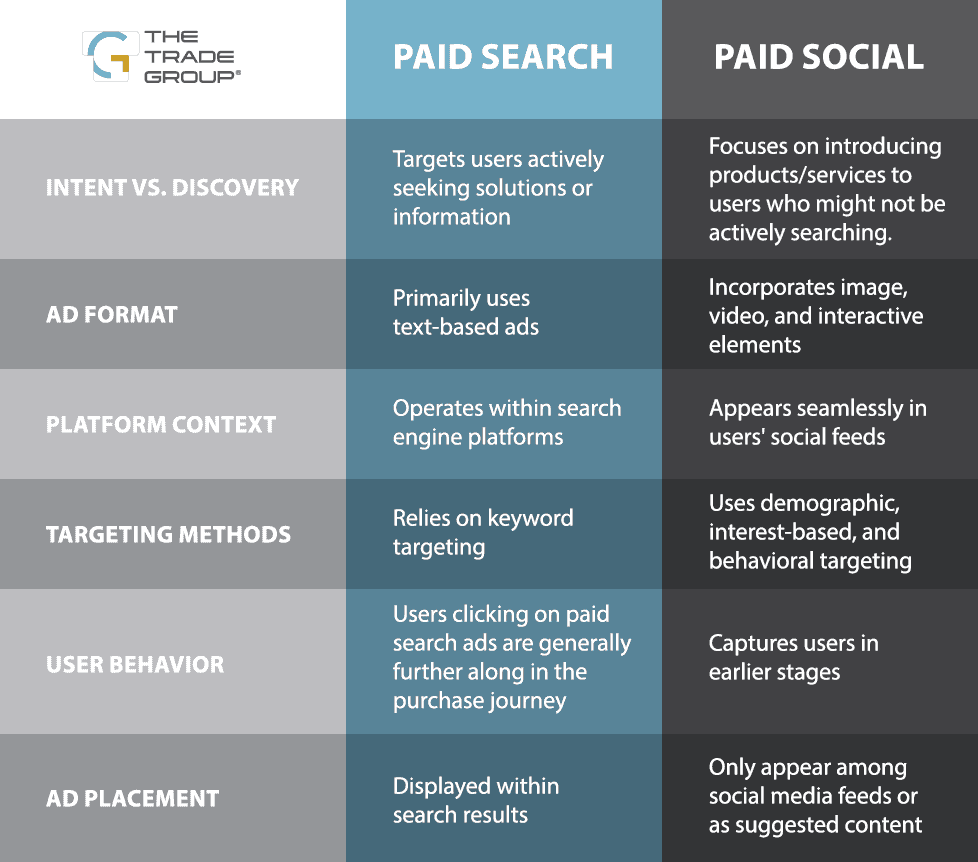
When it comes to getting noticed in the digital landscape, paid search and paid social Advertising have become go-to strategies. Each approach has its advantages that fit different parts of the customer’s journey.
The primary distinction lies in the ad network each method employs. This determines where ads will appear, what kind of format they take, and how the ads performance is measured. This detailed guide will explore the disparities between these two advertising methods, enabling you to make intelligent decisions for your marketing campaigns.
What is Paid Search Advertising?
Paid search advertising is often referred to as Pay-Per-Click (PPC) or Search Engine Advertising revolving around placing text-based ads on search engine result pages (SERPs). Additionally, PPC advertising is positioned above the organic search results.
The most prominent player in this field is Google Ads, where advertisers bid on keywords relevant to their offerings. When a user searches for those keywords, the ads are displayed prominently at the top or bottom of the search results.
Here are a few key features of paid search advertising:
- Keyword Targeting: Advertisers select keywords that match user search queries, ensuring their ads appear when potential customers are actively searching for related products or services.
- Cost Control: PPC campaigns allow you to set budgets and bid amounts, ensuring you have control over your spending.
- Immediate Visibility: Paid Search ads offer instant visibility, driving targeted traffic to your website.
- Performance Tracking: Detailed analytics provide insights into impressions, clicks, conversions, and other metrics, facilitating data-driven optimizations. Also highly focused on direct response actions like purchase or sign-ups.
- Ad Extensions: Additional information, such as location, phone number, or site links, can be displayed alongside the ad, enhancing its relevance.
Overall, paid search advertising stands as a cornerstone of modern business promotion. Its significance lies in the ability to capture immediate attention from potential customers actively seeking your products or services. Advertising isn’t just a choice—it’s a strategic imperative for businesses aiming to thrive and succeed in the competitive online arena.
What is Paid Social Advertising?
Paid social advertising operates within social media platforms like Facebook, Instagram, Twitter, and LinkedIn. Instead of targeting search queries, it leverages user demographics, interests, behaviors, and connections to display ads to the most relevant audience segments.
This advertising strategy is where you can pay to advertise your brand to more consumers on social media.
Here’s a list of key features for paid social advertising:
- Audience Targeting: Ads can precisely target specific demographics, interests, behaviors, and even custom audiences based on user data.
- Visual Appeal: Ads often include visuals, such as images or videos, making them more engaging and shareable.
- Diverse Ad Formats: Each social media platform offers a range of ad formats, from carousel ads to sponsored posts, enabling creating storytelling.
- Brand Awareness: Paid social is effective for building awareness and connecting with users in a more relaxed and social environment.
- Engagement metrics: Metrics such as shares, likes, comments, and click-through-rates (CTR) indicate how well the ad resonates with the audience.
Regardless of a business scale or budget, paid social advertising’s scalability and flexibility make it an accessible avenue for growth. Its precision targeting, real-time analytics, and interactive formats yield efficient resource allocation and heightened returns on investment.
Both advertising platforms represent distinct approaches in the world of digital marketing, each with its own strengths and nuances. Understanding these key differences is essential for marketers to tailor their strategies effectively and achieve their specific campaign goals.
Here are the precise differences between paid search and paid social.

Both digital advertisements are pivotal for crafting effective marketing strategies. Marketers must recognize the differing user intents, ad formats, platform contexts, targeting methods, and user behaviors associated with each approach.
By leveraging these differences, brands can strategically position themselves at various stages of the customer journey, driving conversions, and nurturing leads. Whether seeking immediate conversions through intent-driven searches or aiming to raise brand awareness through engaging visuals in social feeds, these key differences empower marketers to maximize their advertising impact.
How to Select the Right Approach for your Campaign
Choosing the right advertising approach depends on your marketing objectives, target audience, and budget. For instance, if you’re looking to attract users actively seeking your product, paid search is effective. On the other hand, if your goal is to enhance brand visibility and connect with a broader audience, paid social would be more suitable.
Conclusion
Leveraging both digital strategies strategically allows businesses to cover a wider spectrum of user intent, visibility, and ultimately foster brand growth within the digital environment. By understanding both paid search and paid social advertising, brands can craft comprehensive marketing campaigns that drive conversions and establish a meaningful digital presence.
The Trade Group is a full-service trade show and event marketing company. We will work with you to create an exhibit or an event that brings in leads and helps you achieve your business goals. Contact us here or give us a call at (800) 343-2005.
Photo credit: Pexels




